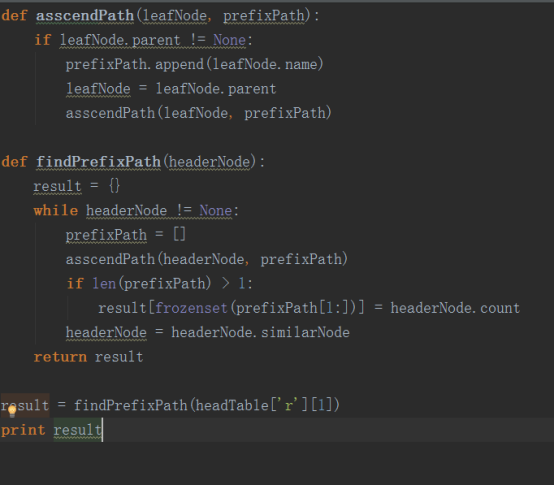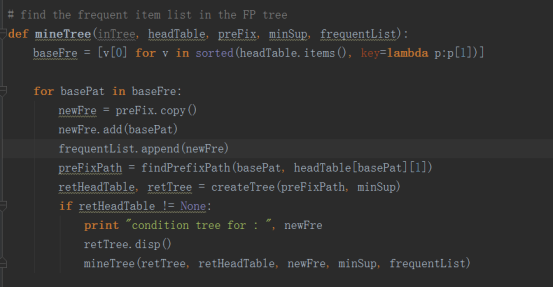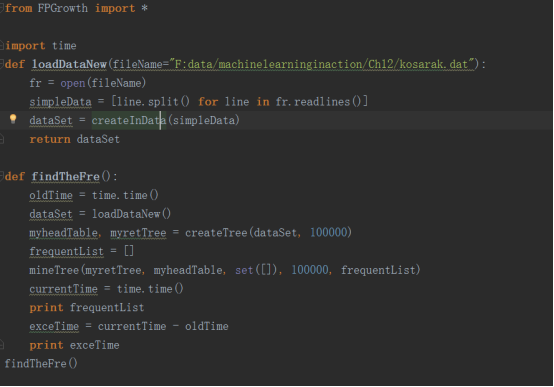第十二章 使用FP-growth算法高效的发现频繁项集
一.导语
FP-growth算法是用于发现频繁项集的算法,它不能够用于发现关联规则。FP-growth算法的特殊之处在于它是通过构建一棵Fp树,然后从FP树上发现频繁项集。
FP-growth算法它比Apriori算法的速度更快,一般能够提高两个数量级,因为它只需要遍历两遍数据库,它的过程分为两步:
1.构建FP树
2.利用FP树发现频繁项集
二.FP树
FP树它的形状与普通的树类似,树中的节点记录了一个项和在此路径上该项出现的频率。FP树允许项重复出现,但是它的频率可能是不同的。重复出现的项就是相似项,相似项之间的连接称之为节点连接,沿着节点连接我们可以快速的发现相似的项。
FP树中的项必须是频繁项,也就是它必须要满足Apriori算法。FP树的构建过程需要遍历两边数据库,第一遍的时候我们统计出所有项的频率,过滤掉不满足最小支持度的项;第二遍的时候我们统计出每个项集的频率。
三.构建FP树
1.要创建一棵树,首先我们需要定义树的数据结构。
这个数据结构有五个数据项,其中的parent表示父节点, children表示孩子节点, similar表示的相似项。
2.创建一棵Fp树
def createTree(dataSet, minSup=1):
headerTable = {}
# in order to catch the all the item and it's frequent
for transaction in dataSet:
for item in transaction:
headerTable[item] = headerTable.get(item, 0) + dataSet[transaction]
# delete the item which is not frequent item
for key in headerTable.keys():
if headerTable[key] < minSup:
del(headerTable[key])
frequentSet = headerTable.keys()
# if the frequentSet is empty, then we can finish the program early
if len(frequentSet) == 0:
return None, None
# initialize the begin link of headerTable is None
for key in headerTable.keys():
headerTable[key] = [headerTable[key], None]
# initialize the fp-tree
retTree = treeNode("RootNode", 1, None)
# rearrange the transaction and add the transaction into the tree
for transData, times in dataSet.items():
arrangeTrans = {}
for item in transData:
if item in frequentSet:
arrangeTrans[item] = headerTable[item][0]
if len(arrangeTrans)>0:
sortTrans = [v[0] for v in sorted(arrangeTrans.items(), key=lambda p:p[1], reverse=True)]
updateTree(sortTrans, retTree, headerTable, times)
return headerTable, retTree
def updateTree(sortTrans, retTree, headerTable, times):
if sortTrans[0] in retTree.children:
retTree.children[sortTrans[0]].inc(times)
else:
retTree.children[sortTrans[0]] = treeNode(sortTrans[0], times, retTree)
if headerTable[sortTrans[0]][1] == None:
headerTable[sortTrans[0]][1] = retTree.children[sortTrans[0]]
else:
updateHeader(headerTable[sortTrans[0]][1], retTree.children[sortTrans[0]])
if len(sortTrans) > 1:
updateTree(sortTrans[1::], retTree.children[sortTrans[0]], headerTable, times)
def updateHeader(nodeToTest, targetNode):
while nodeToTest.similarNode != None:
nodeToTest = nodeToTest.similarNode
nodeToTest.similarNode = targetNode
四.从一棵FP树中挖掘频繁项集
从一棵FP树中挖掘频繁项集需要三个步骤,首先我们需要找到所有的条件模式基,其次是根据条件模式基创建一棵条件FP树,最后我们不断的重复前两个步骤直到树只包含一个元素项为止
首先我们要寻找条件模式基,那么什么是条件模式基呢?所谓的条件模式基就是以查找元素结尾的所有路径的集合。我们可以根据headertable中的nodelink来找到某一个元素在树中的所有位置,然后根据这些位置进行前缀路径的搜索。以下是它的python代码:

现在我们知道了如何找条件模式基,接下来就是创建一个FP条件树。在创建树之前我们首先要知道什么是FP条件树,所谓的FP条件树就是将针对某一个条件的条件模式基构建的一棵FP树。以下是python代码

五.一个浏览新闻共现的例子
korasa.dat中有100万条数据,我们需要从这一百万条数据中知道最小支持度为100000的频繁项集。如果采用Apriori算法时间非常的长,我等了好几分钟还没出结果,就不等了。
然后采用本节的FP-growth算法只用了11秒多就算完了。以下是具体的代码

六.总结
FP-growth算法作为一种专门发现频繁项集的算法,比Apriori算法的执行效率更高。它只需要扫描数据库两遍,第一遍是为了找到headerTable,也就是找到所有单个的频繁项。第二遍的时候是为了将每一个事务融入到树中。
发现频繁项集是非常有用的操作,经常需要用到,我们可以将其用于搜索,购物交易等多种场景。